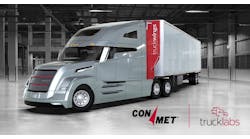Technicians are no stranger to diagnostic fault codes. In fact, Pitstop, a fleet maintenance telematics solution, has detected over 17 million fault codes, which can boil down to over 200 per day for a fleet of 500 vehicles. With so many issues to resolve, its inevitable that maintenance managers must prioritize, from the top fault codes that must be addressed to those that won’t entirely ruin someone’s day.
The below represent some of the issues that require immediate attention as well as those that can be delegated to another day.
Aftertreatment faults
Aftertreatment 1 diesel exhaust fluid tank volume: SPN 1761
SPN 1761 indicates that the volume of diesel exhaust fluid in the aftertreatment system storage container, exhaust bank 1, is lower than it should be. This could eventually stop the vehicle from starting if left unfilled. Some symptoms include:
- Yellow Check lamp illuminated
- No Aftertreatment Diesel Exhaust Fluid (DEF) dosing
- DEF level gauge reading incorrectly
- Reduced power and possibly a 5MPH derate
Potential causes include a DEF tank pickup assembly or sensor failure and running out of DEF fluid.
Aftertreatment 1 Diesel Particulate Filter Differential Pressure: SPN 3251
If this fault code appears, then a technician knows that the exhaust differential pressure between the intake and the exhaust of a DPF in exhaust bank 1 is too high or low. This issue is particularly critical, as it can harm engine performance. External symptoms for this fault include:
- Check engine light
- Engine protection derate
- The aftertreatment diesel particulate filter lamp will be illuminated and will begin to flash as the severity of the soot load increases.
Meanwhile, one potential cause for this code could be that the soot load of the aftertreatment DPF is higher than it should be.
Aftertreatment 1 Outlet NOx 1: SPN 3226
SPN 3226 triggers when the NOx sensor detects an incorrect reading from the NO and NO2 departing the aftertreatment system. Symptoms of this fault code include:
- Check engine light
- Engine stalling or misfiring
- Engine performance issues
- Vehicle not starting
In addition, potential causes can include:
- CCD Bus (-) circuit open between Powertrain Control Module (PCM) and Transmission Control Module (TCM)
- CCD Bus (+) circuit open between PCM and TCM
- Transmission CCD bus wiring damaged
Engine Exhaust 1 NOx 1: SPN 3216
Fault code SPN 2116 indicates that there’s a problem with the intake sensor of the SCR system, potentially due to the amount of combined NO and NO2 in the exhaust in exhaust bank 1. Symptoms include of this issue include:
- The ECU will illuminate an engine warning light
- High fuel consumption
- Erratic acceleration
- Engine misfire and soot buildup
As with other aftertreatment issues, potential causes for SPN 3216 include soot buildup in the system or burnt or damaged cables.
Fault codes to watch out for
Coolant Level: SPN 111
This fault code was triggered over 12,000 times of Pitstop’s 17 million recorded incidents. Specifically, it refers to the ratio of coolant liquid in the engine cooling system in comparison to the total cooling system volume and indicates that it is lower than it should be. Some of this fault’s symptoms include:
- Check engine light
- Rising temperature gauge
- Automatic engine cut-off
- Distinct sweet smell
Potential causes include:
- External coolant leak
- Faulty intake manifold gasket
- Faulty radiator cap
- Faulty EGR cooler
Fuel/Rail System Pressure – Too Low Bank 1: SPN 135
This code may appear when the fuel system pressure is below the necessary levels for the engine to function, which can lead to misfires, rough running, or reduced engine power. Some presenting symptoms include:
- Check engine light
- Engine stalling
- Fuel efficiency drops
The causes for a pressure lack in the fuel rail can also range from a weak fuel pump to a clogged filter or screen, including the below:
- Restricted fuel supply line
- Faulty fuel pump driver module
- Faulty fuel pressure sensor
Engine Exhaust 1 NOx 1: SPN 3216
SPN 3216 refers to the sensors tracking the amount of nitrogen oxide coming from a diesel vehicle, and a fault in this can result in compliance issues with emissions regulations. Specifically, the code notifies the user of the combined NO and NO2 in a vehicle’s exhaust in exhaust bank 1, specifically as a ratio of NOx molecule parts per million non-NOx molecules. Some symptoms include:
- The ECU will illuminate an engine warning light
- High fuel consumption
- Erratic acceleration
- Engine misfire and soot buildup
The two primary causes of this fault code are burnt or damaged cables.
Engine Fuel Delivery Pressure: SPN 94
This fault code indicates that the injection pump is receiving the wrong fuel pressure from the supply pump, which can be critical to an asset’s performance and fuel economy. Some symptoms of this issue are:
- Low fuel economy and constant refuelling
- Blackened spark plugs
- Spark plugs that are wet with fuel
- Restrictions in the return line
Potential causes for this issue include:
- Dirty fuel filter
- Incorrect tank venting
- Clogged return line
- Faulty electrical control
Low priority fault codes
RDF mounting misaligned: SPN 524042
This fault code is one of the most unobtrusive that a technician can note. At best, it may only indicate a slight misalignment if the RDF is broken, bent, or loose and does not need to be immediately addressed until the vehicle’s next preventative maintenance cycle.
J1939 network #1 primary vehicle network: SPN 639
This electrical fault code indicates that the engine control module (ECM) has lost its link with another device via the SAE J 1939 data link. Ultimately, this issue will not affect a driver’s uptime and can wait for its next preventative maintenance visit.
Control Module Improper Shutdown: SPN U3001
Technicians may note this fault code when the vehicle control module identifies a system voltage of less than 9 Volts for 5 seconds while the ignition is on. This can occur due to deteriorating connector pins or a faulty control module setting.
High speed CAN communication bus: SPN U0001
Another fault code that can be triggered with a faulty control module, SPN U0001 indicates that the High Speed Communication Area Network (CAN) Bus is struggling to process and move messages throughout the vehicle, which may also trigger a failed module code or specific vehicle issue. If a dead battery causes U0001 to appear, the code might just need to be cleared, or it can be addressed during the vehicle’s next PM cycle.
About: Pitstop is a fleet maintenance platform that partners with leading ELD/Telematic Providers enabling fleets to simplify their maintenance strategy by leveraging the abundance of data available from their vehicles. Pitstop’s predictive maintenance sends prioritized, prescriptive, and predictive VMRS code keys to help you make better decisions about maintenance issues, reducing maintenance/operations expenses (up to $2000/vehicle per year) and reducing unscheduled asset downtime (up to 25%).



